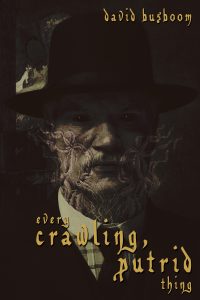
David Busboom
JournalStone (April 8, 2022)
Reviewed by Andrew Byers
I will always appreciate JournalStone bringing me the work of many horror authors I wouldn’t otherwise have been exposed to. That’s certainly the case with Every Crawling, Putrid Thing (what a great title!), which is David Busboom’s debut collection of fourteen short stories and a wonderful novella, “Nightbird,” which closes out the collection.
Busboom has an uncanny ability to write across the full breadth of horror and touch on many topics I personally love—here he includes several pure monster stories (he must really like dinosaurs), some Cthulhu Mythos stories, a King in Yellow tale, and several involving some nicely gruesome physical transformations and body horror. There’s something here for almost every taste in horror. Because this is a very substantial collection of disparate stories, I won’t go into detail about every one but will focus on a few of my favorites, which should give you a sense for the breadth of Every Crawling, Putrid Thing.
I suspect that David Busboom loves monsters, especially dinosaurs. He seems to feature them prominently in his work, from minor surreal pieces like “Can’t Stop Here,” which features a man getting attacked by dinosaurs out of nowhere one night while he’s driving to his girlfriend’s house, to stories like “He Who Takes from Gwangi,” which seems to involve a sizable fraction of Chile being inexplicably transported into the prehistoric past, with predictably tragic results. One of my favorites in the collection was “In Kansas,” which features monsters as just one horror element among several. Here, Hannah is an office worker who first must deal with a mass shooter in her workplace—terrifying enough on its own—and then with whatever is killing people as they try to escape through the flooded parking lot that surrounds her building. (Interestingly, Hannah seems to be the ex-girlfriend of a character in “Anatomy of a Broiler Oven,” another story in the collection, though I don’t see any other connections between the two stories, but it’s a fun little touch.) In each of these stories, reality, order, and structure to the universe all seem to be breaking down, which turns a simple monster story into something closer to cosmic horror, which I thoroughly appreciated.
Busboom has also included a nice set of four Cthulhu Mythos tales and one King in Yellow story, or at least that’s how I think of his story “From the Dusty Mesa,” which intersperses the perspectives of a detective and the female ritual killer he is hunting who serves the Pallid One. It’s certainly got a very King in Yellow vibe to me. Several of the Cthulhu Mythos stories (“The Vindication of Y’ha-nthlei” and “In Their Reeking Talons”) are set mid-apocalypse, with rampaging Deep Ones and Shoggoths in the midst of rising up to destroy human civilization.
I also detected a theme of “horrifying physical transformations” in the collection, which is a perennial favorite. In “She Said She Was a Magic Mama,” we’ve got a philandering alderman mid-transformation into a betentacled monstrosity. I won’t go into too many specifics on what happens in “Hairworm,” but suffice it to say that the title says it all. And then we’ve got “Anatomy of a Broiler Oven.” I love this story more than I should, really; this is the tale of a man becoming a pizza. There’s no way that premise should be anything other than ridiculous, but yet, in Busboom’s hands, the story is as gruesome as it is darkly absurdist. Only a skilled writer can take that concept and do something meaningful with it.
And lastly, we must talk about “Nightbird.” Because it’s the lone novella in the collection, comprising about 40% of the book’s wordcount, it better be good. Oh boy, is it. Busboom’s characterization is on point here. Isaac is a young man who was always drawn to the numinous growing up, having some inexplicable experiences. At the age of sixteen he meets then soon loses his virginity to a girl who calls herself Lilith. Lilith is…far more than she seems. She seems to have a cult surrounding her, and she’s much, much more than a simple but alluring slightly older teenager who picks up a lonely boy in a mall bookstore. Lilith is an ancient being older than humanity, she’s a witch, a demigoddess, a harpy. They soon part ways, but Isaac never forgets Lilith, and years later his complicated feelings—an obsession really—are rekindled when he discovers how he can re-contact Lilith and, if he so chooses, dedicate himself to her. That’s going to come at a cost, because Isaac’s live-in girlfriend Elizabeth is dealing with a significant bout of clinical depression and she relies on him and their relationship for stability and hope. (By the way, Elizabeth’s struggles with mental illness are exceedingly well-told.) But we all know how obsession works, don’t we? This was a really powerful story made all the more so when I read in the author’s notes just how many semi-autobiographical elements the novella contains.
Just as a general note, I would say that one of Busboom’s greatest strengths as a writer is in the depths of his characterization. Even in something as simple as a straightforward monster attack story, Busboom manages to paint the portraits of real people with depth who happen to be experiencing horrific events. That makes his stories come to life and be much more than they might otherwise. Needless to say, I’m looking forward to reading more from David Busboom in the future. Every Crawling, Putrid Thing is filled with really compelling stories, but his novella “Nightbird” is simply outstanding and worth the price of admission alone. This one is definitely recommended.








